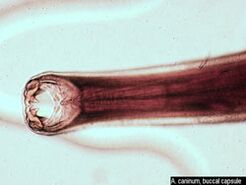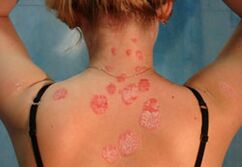Many people who lead a healthy lifestyle have health disorders for the presence of parasites.The emphasis of the body (proper nutrition, physical exercise, stricture procedures) without eliminating the body from the parasite does not give a pronounced positive effect.According to the World Health Organization, Helminths are localized not only in the gastrointestinal tract, but also in vital bodies: the brain, heart, lungs, liver, kidneys.Helminths in the processes of their life differ special substances - toxins that are strong poisons and allergens.These are the simplest, fungi and helmins that are the driving mechanism for many chronic diseases: cholecystitis, college, pancreatitis, colitis, diabetes melitus, bronchial asthma, atopic dermatitis.

Chronic fatigue, irritability and anxiety, hyperactivity in children, anemia, fragile nails and hair, problematic skin, headaches, appetite disorders, immunity reduction - this may be signal of the current disease.With a long stay of the parasite in the human body, the immune system suffers very much.In the process of constant struggle with foreign antibodies, there is exhaustion, ie the development of secondary immunodeficiency.The disease with parasites leads to hypovitaminosis, exhaustion of microelements: potassium, copper, manganese, selenium, zinc, magnesium, silicon;Breach of hematopois, hormonal failure, vascular permeability has been violated, body cancer protection suffers.
For millennia, people, mostly herbal food, have received antimicrobial, antiparasitive and antivirus natural active substances with it.The reduction of wild plants, fruits, berries, replacement of their vegetables and fruits, thermal and industrial treatment led to a reduction in the consumption of natural volatile and antibiotics.As a result, a person became easy prey for many microorganisms.The intensive development of the drug industry produced by antibiotics has led to a reduction in immunity.
Determination of parasites

Parasites (from Greek. Parasitos - overlap, parasite) - Donji herbal and animal organisms that live outside or within the second organism (owner) and eat at his expense.The parasites arose in the process of historical development of the organism of free-living forms.Their adaptation of certain conditions of life implied the simplification of their organization, the development of special fixing bodies, increased development of genital bodies, breathing, which allows existence in an infinite environment.Parasites include numerous helmints, fungi, viruses, protozoa, CRM, crabs, spider-spider, insects.Parasite owners can be bacteria, simplest, plants, animals and people.Parasites are subjected to a complex development cycle: they sometimes need a change in 2-3 owners whose body is the middle (Helminthes pass the phase larva) or the final (Helminths are becoming mature, invasive).The parasites are caused by the weakening and exhaustion of the host body, cause numerous diseases.
Helminsants can parasitize in all tissues and authorities of a person, but the most common place of their localization is a food tract.Taurus and pork Tapeworm, a wide tape are fixed in the upper point of the hose, also paras ascaris.Dwarf Tabbell is mainly localized in the lower third of the small intestine, Vlasovac - in a thick hose, in the gallows of liver and channel of the pancreas, in the lower parts of thin and in all parts of the colon.Thus, the distribution of different types of hermimans along the digestive tract in search of the most favorable living provides them with an individual survival and creates the conditions for the development of several species in one person.
Classification
Distribution:
- Ubiquette - Meet everywhere.
- Tropical - distributed in tropical climatic zones.
According to biological and epidemiological characteristics: Geohelminths - a disease in which the creams are first developed in the human body, and then on the non-revitalization of the substrate, more often in the country.Biohelminths is a disease in which the biological cycle of Helminth Development is necessarily taking place in the body of other living beings, except for the person.They vary between end owners, in which the body can be found for clays for sexually mature stage, as well as medium, where the parasite in the liring phase or its reproduction is not sexually.A person is more often the final host, less often.Connection helminthiasis is a disease in which parasites differ from the human body with mature or almost mature, as a result of another person's infection or is possible or re-cheap.
Depending on the localization of the parasite in the body: educational - live in the intestinal cavity and other cavities of a person (for example, ascaride, tape) and tissue - live in tissues.

At the place of residence on the owner:
- Outdoor (mosquitoes, blinds, leeches, ears).
- Internal (Helminthiasis):
- Round worms (Nematode - Ascarides, Vlasov, Pinworms, Strungyloidi);
- Flat worms:
- Trematodes (plates - cat Bickelter, Schistosomi);
- Cestodes (ribbons - Worms - Taurus and Pork Tapeworm, Dwarf Tabbell, wide cassette, echinococcus).
- Bacteriosis (staphylococcus, streptococcus).
- Protose (Ambas, Lamblia, Trichomonas, often owners of chlamydia and AIDS virus).
- Mikoze (fungal diseases) - example, Candida.
As the parasites adjust
- Long Lifetime (Helminths lives in the body for years, and sometimes the one as much as the owner of the life of the parasite);
- ability to combat or modify the immune response of the host body (immunodeficities arises, conditions are created for the penetration of pathogen agents from outside, as well as revive the inner focal pallet of infection);
- Many types of Hermimans, entering the digestive tract, differ anti -enzime, which saves them from death;The digestive process is disturbed, the toxic allergic reactions appear, which are different gravity: urticaria, bronchial asthma, atopic dermatitis;
- Development phase (egg, larva, change of owner);
- The ability of eggs for years persevere in an external environment;
- Sexual reproduction in which genetic data is exchanged, and this is the highest stage of development, which leads to an increase in heterogeneous population, ie parasites become less vulnerable;
- the absence of immunoprophylaxis methods, because the immune response is weak and unstable;
- Helminth widespread, many habitats (water, soil, air, plants and animals).
How parasites are entering the body

You can infect yourself not only through dirty hands.Animal hair is a worm holder (ascaride), Lamblia.Pin eggs that fell from wool remain sustainability up to 6 months and through dust, toys, carpets, underwear and bedding and hands fall into food.The dog through humid breathing scatters eggs at a distance of 5 meters (cat - up to 3 meters).The fleas from dogs also bear the church eggs.Askarid eggs enter the body with poorly washed vegetables, fruits, berries, greenery, dirty hands and spread to flies.And a miscuted barbecue or domestic Lard is the path of a trichinosis infection;Bad salty fish, caviar - desisthorchiasis and wide cassette.
So there are several ways to enter the body:
- Alimentary (through infectious food, water, dirty hands);
- Contact-household (through homes, from infected family members, pets);
- Through insects for bloodshed;
- Active (in which larva penetrates the skin or mucosa during contact with infected soil, when bathing in open tanks).
Prevention
Here are a few rules to follow to prevent the penetration of the parasite into the body:
- It is not recommended to drink water from natural resources and to an unknown area.
- You can't eat unwarred vegetables and fruits.
- It is advisable to keep against mosquitoes, ticks and other blood insects that can be parasite carriers.It is necessary to use special means of protection from them, and in places where there are a lot, wear pants and long sleeved shirts.
- Before traveling to some countries, it is necessary to vaccinate from typhous, plague, tropical fever and other infectious diseases.Going to places where Malaria's mosquito is located, you need to take antimal tablets.The gathering on a long journey, where ticks can be, is important to roll from Encephalitis Tick -Borna.
- Don't let children hug and kiss dogs, cats and other pets. Take care of the pet health - take them to remove courses.
- Follow personal hygiene rules, keep the cleanliness of the house.
- Conduct periodic preventive antiparazivative courses throughout the family.
Children and parasitic invasions

The most vulnerable to parasite effects are children.They are infected with different types of parasites through dirty hands, sand, soil and water.Sometimes intrauterine can occur in intrauterine, because the simplest, bacteria, viruses, candida and herminth larva can penetrate the fruit through the flow of blood, as well as during birth through the birth of channels.Zbog širenja svoje motorne aktivnosti, u dobi od 1,5-3 godine mogu se zaraziti kod kuće, u šetnji, u vrtiću kada se kontaktiraju zagađene predmete (ulične cipele, pod, igračke, zajedničke prostorije), kao i u prizemlju), kao i u prizemlju), kao i u prizemlju), kao i u prizemlju), kao i u prizemlju), kao i u prizemlju), kao i u prizemlju), kao i uground floor).High probability Invasion by parasites is noticed with hygienic rules (unweld hands, eating unwashed vegetables and fruits, eat raw water from natural ponds and swimming in them).Only the eggs of pins and dwarfs are transmitted directly from person to person.The eggs of other hemimans for ripening must necessarily enter the body of the intermediate host or a suitable environment - soil or water.At the age of 1.5-3, the charts of children with Helminths can reach 80%.
More than 90% of all herminth diseases in children are caused by intestinal nemodes that parasitize in lumen on the hoses (ascaris, pinworms), nematoders that paras in the intestinal wall or other bodies (ankylastics, not -cinel and intestinal UCTUMA) are less common.In children, subject to elementary hygiene (improperly underdoed meat or fish, non-watered vegetables and fruits, non-inflammatory water from natural reservoirs), practically no worms (trematodes) and cassettes (cestodes).
How can a child get infected?
Infection is done when the larger eggs enter the body.Eggs enter the environment with the feces of infected people and animals.They have microscopic dimensions, they are very resistant to various influences and can long maintain vitality outside the body (in the ground, on the surface of facilities or products, in the creases of bed linen).Once in the children's oral cavity, they destroy eggs partly, partially destroying, through sour, aggressive stomach environment and is activated in the intestines, where the conditions for the development of egg adults are most favorable.Preschool and preschool children are especially sensitive to Herminthic invasions, because they still have imperfect barriers of the gastrointestinal tract.
Measures to prevent Helminthiasis in children: All family members to respect hygienic rules, try preventing a close contact of the child and his personal belongings with pets;It is important to ensure that the child does not choose various objects;prevent contact with animals;It is important to instill in children's personal hygienic skills (wash your hands with soap after the street and visit the toilet);It is recommended to run wet clean cleaning at home periodically, wash with soap, especially in the presence of pets, as well as toys brought to house walking to the house;Accumulated carpets, upholstered furniture and upholstered toys;Do not give a child unwilled vegetable and fruit, not thermally untreated meat and fish, raw water from the natural tanks.
Signs of Helmint Invasion in children

Most often, the child must guess about Helminthic Invasion indirect signs.The likelihood of Herminthic invasion is very high if there are such symptoms such as: salivation, nausea, reduced appetite, frequent and dizziness of the child in the evening, without a bad night's sleep, accompanied by a bad night's sleep, accompanied by screaming, awakening,"Fidgeting", grinding teeth, itching in the perineum.Often parasites lead to body allergization, leather reactions appear in the form of atopic dermatitis (usually stubbornly stubborn, which is difficult to symptomatic therapy).If the worms are in the child or in one of the family members, it is necessary to treat the entire family to avoid forming the focus of the infection.In this situation, it is important to strengthen hygienic measures, especially, cook and iron on both sides of bed linen and personal underwear.
























